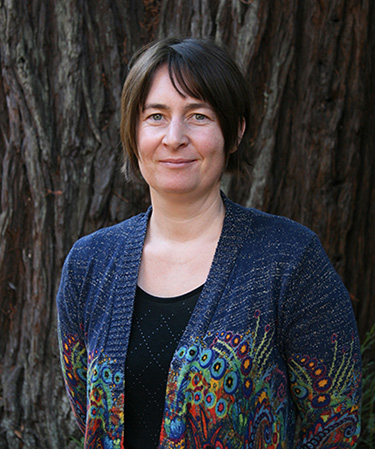Campus News
Astronomer Alexie Leauthaud wins prestigious Packard Fellowship
Leauthaud is the 13th UCSC faculty member, and sixth UCSC astronomer, to receive a Packard Fellowship.

The David and Lucile Packard Foundation has awarded a Packard Fellowship for Science and Engineering to Alexie Leauthaud, assistant professor of astronomy and astrophysics at UC Santa Cruz.
The Packard Fellowship, one of the nation’s most prestigious honors for early-career scientists, gives Leauthaud $875,000 over the next five years to support her research on the connection between dark matter and galaxy formation. She will use the technique of “gravitational lensing” and data from a large imaging survey covering tens of millions of galaxies to address how galaxies and cosmic structures grow over time within a cosmological landscape dominated by invisible dark matter.
Leauthaud leads the galaxy formation working group for the “HSC Survey,” which uses the Hyper Suprime Camera on the Subaru Telescope in Hawaii.
“This is an impressive state-of-the-art instrument that stands 3 meters high, weighs 3 tons, and is the largest camera in the world,” she said. “Our team uses this camera to collect the most accurate and deep data available to measure gravitational lensing.”
Gravitational lensing occurs when the gravity of a galaxy in the foreground of an image bends and distorts the light from another galaxy behind it. The bending of light by gravitational lensing can be used to measure the mass of the object in the foreground, including the invisible mass of the galaxy’s dark matter halo. The data collected by the HSC Survey over the next three years will enable Leauthaud to characterize the link between galaxies and dark matter and map out the growth of cosmic structures over time in ways that were not previously possible.
“The results of this program have the potential to revolutionize our understanding about the fundamental makeup of the universe,” she said.
Although the nature of dark matter remains a mystery, it appears to account for about 82 percent of the matter in the universe. As a result, the evolution of structure in the universe has been driven by the gravitational interactions of dark matter, while the ordinary matter that forms stars and galaxies follows the distribution of dark matter. Galaxies form in the center of dark matter halos (“big fluffy balls of dark matter”), Leauthaud explains, while on larger scales, dark matter is distributed in a vast cosmic web, with clusters of galaxies forming at the nodes of the web.
Leauthaud wants to understand the connections between galaxies and dark matter across a broad range of mass scales, from tiny dwarf galaxies to enormous clusters of galaxies (the largest structures in the universe).
The techniques developed by Leauthaud’s team will pave the way for major cosmology projects now in the planning stages, such as the Large Synoptic Survey Telescope and the Wide-Field Infrared Telescope, which are the top priorities in the 2020s for the National Science Foundation and NASA, respectively.
Leauthaud is the 13th UCSC faculty member, and sixth UCSC astronomer, to receive a Packard Fellowship, awarded by the David and Lucile Packard Foundation to support young scientists and engineers who show exceptional promise and creativity. It is among the nation’s largest nongovernmental fellowships, designed to allow maximum flexibility in how the funding is used.
Leauthaud earned her M.S. at the Institute of Astrophysics in Paris and her Ph.D. at the Laboratory of Astrophysics in Marseille, both in astronomy, astrophysics, and cosmology. Before coming to UC Santa Cruz in 2016, she was a researcher at the Kavli Institute for the Physics and Mathematics of the Universe in Tokyo.